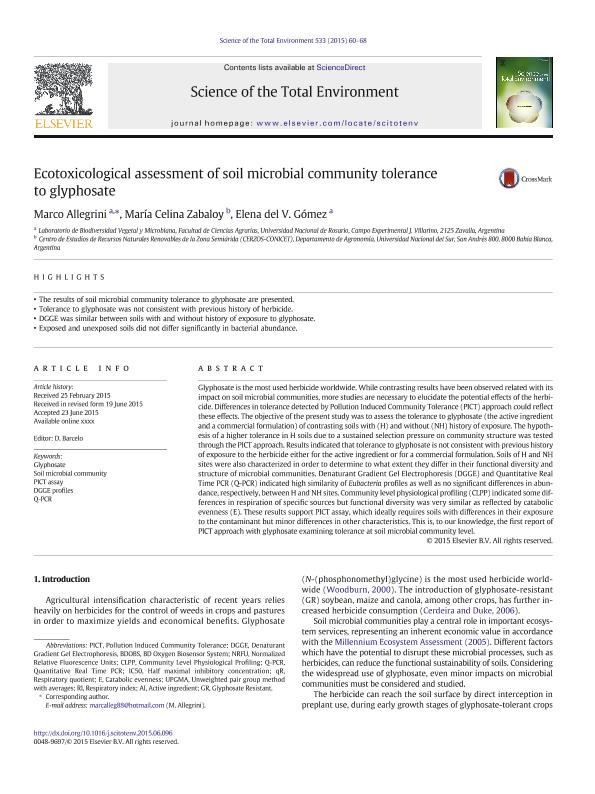Mostrar el registro sencillo del ítem
dc.contributor.author
Allegrini, Marco

dc.contributor.author
Zabaloy, Maria Celina

dc.contributor.author
Gomez, Elena del V.
dc.date.available
2017-01-18T20:01:05Z
dc.date.issued
2015-11
dc.identifier.citation
Allegrini, Marco; Zabaloy, Maria Celina; Gomez, Elena del V.; Ecotoxicological assessment of soil microbial community tolerance to glyphosate; Elsevier Science; Science of the Total Environment; 553; 11-2015; 60-68
dc.identifier.issn
0048-9697
dc.identifier.uri
http://hdl.handle.net/11336/11585
dc.description.abstract
Glyphosate is the most used herbicide worldwide. While contrasting results have been observed related with its impact on soil microbial communities, more studies are necessary to elucidate the potential effects of the herbicide. Differences in tolerance detected by Pollution Induced Community Tolerance (PICT) approach could reflect these effects. The objective of the present study was to assess the tolerance to glyphosate (the active ingredient and a commercial formulation) of contrasting soils with (H) and without (NH) history of exposure. The hypothesis of a higher tolerance in H soils due to a sustained selection pressure on community structure was tested through the PICT approach. Results indicated that tolerance to glyphosate is not consistent with previous history of exposure to the herbicide. Studies of community structure based on Denaturant Gradient Gel Electrophoresis (DGGE) and Quantitative Real Time PCR (Q-PCR) showed that composition and abundance of bacteria, respectively, did not differ significantly between H and NH soils, in accordance with PICT results. Consequently, the lack of significant differences in tolerance in most cases could be partially explained by a similar community structure. This is, to our knowledge, the first report of PICT approach with glyphosate examining tolerance at soil microbial community level. Future culture-independent analysis focused on specific groups of microorganisms instead of whole microbial communities could be important to provide stronger evidences supporting our results and conclusions.
dc.format
application/pdf
dc.language.iso
eng
dc.publisher
Elsevier Science

dc.rights
info:eu-repo/semantics/openAccess
dc.rights.uri
https://creativecommons.org/licenses/by-nc-nd/2.5/ar/
dc.subject
Glyphosate
dc.subject
Soil Microbial Community
dc.subject
Pict Assay
dc.subject
Dgge Profiles
dc.subject
Q-Pcr
dc.subject.classification
Biología Celular, Microbiología

dc.subject.classification
Ciencias Biológicas

dc.subject.classification
CIENCIAS NATURALES Y EXACTAS

dc.subject.classification
Ciencias del Suelo

dc.subject.classification
Agricultura, Silvicultura y Pesca

dc.subject.classification
CIENCIAS AGRÍCOLAS

dc.title
Ecotoxicological assessment of soil microbial community tolerance to glyphosate
dc.type
info:eu-repo/semantics/article
dc.type
info:ar-repo/semantics/artículo
dc.type
info:eu-repo/semantics/publishedVersion
dc.date.updated
2017-01-17T19:22:22Z
dc.journal.volume
553
dc.journal.pagination
60-68
dc.journal.pais
Países Bajos

dc.journal.ciudad
Ámsterdam
dc.description.fil
Fil: Allegrini, Marco. Consejo Nacional de Investigaciones Científicas y Técnicas; Argentina. Universidad Nacional de Rosario. Facultad de Ciencias Agrarias. Departamento de Sistema de Producción Vegetal. Laboratorio Biodiversidad Vegetal y Microbiana Fitopatologia; Argentina
dc.description.fil
Fil: Zabaloy, Maria Celina. Consejo Nacional de Investigaciones Científicas y Técnicas. Centro Científico Tecnológico Bahía Blanca. Centro de Recursos Naturales Renovables de la Zona Semiárida(i); Argentina
dc.description.fil
Fil: Gomez, Elena del V.. Universidad Nacional de Rosario. Facultad de Ciencias Agrarias. Departamento de Sistema de Producción Vegetal. Laboratorio Biodiversidad Vegetal y Microbiana Fitopatologia; Argentina
dc.journal.title
Science of the Total Environment

dc.relation.alternativeid
info:eu-repo/semantics/altIdentifier/url/http://www.sciencedirect.com/science/article/pii/S0048969715302898
dc.relation.alternativeid
info:eu-repo/semantics/altIdentifier/doi/http://dx.doi.org/10.1016/j.scitotenv.2015.06.096
Archivos asociados
